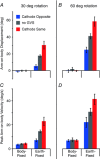Vestibular feedback maintains reaching accuracy during body movement
- PMID: 27730646
- PMCID: PMC5309371
- DOI: 10.1113/JP273125
Vestibular feedback maintains reaching accuracy during body movement
Abstract
Key points: Reaching movements can be perturbed by vestibular input, but the function of this response is unclear. Here, we applied galvanic vestibular stimulation concurrently with real body movement while subjects maintained arm position either fixed in space or fixed with respect to their body. During the fixed-in-space conditions, galvanic vestibular stimulation caused large changes in arm trajectory consistent with a compensatory response to maintain upper-limb accuracy in the face of body movement. Galvanic vestibular stimulation responses were absent during the body-fixed task, demonstrating task dependency in vestibular control of the upper limb. The results suggest that the function of vestibular-evoked arm movements is to maintain the accuracy of the upper limb during unpredictable body movement, but only when reaching in an earth-fixed reference frame.
Abstract: When using our arms to interact with the world, unintended body motion can introduce movement error. A mechanism that could detect and compensate for such motion would be beneficial. Observations of arm movements evoked by vestibular stimulation provide some support for this mechanism. However, the physiological function underlying these artificially evoked movements is unclear from previous research. For such a mechanism to be functional, it should operate only when the arm is being controlled in an earth-fixed rather than a body-fixed reference frame. In the latter case, compensation would be unnecessary and even deleterious. To test this hypothesis, subjects were gently rotated in a chair while being asked to maintain their outstretched arm pointing towards either earth-fixed or body-fixed memorized targets. Galvanic vestibular stimulation was applied concurrently during rotation to isolate the influence of vestibular input, uncontaminated by inertial factors. During the earth-fixed task, galvanic vestibular stimulation produced large polarity-dependent corrections in arm position. These corrections mimicked those evoked when chair velocity was altered without any galvanic vestibular stimulation, indicating a compensatory arm response to a sensation of altered body motion. In stark contrast, corrections were completely absent during the body-fixed task, despite the same chair movement profile and arm posture. These effects persisted when we controlled for differences in limb kinematics between the two tasks. Our results demonstrate that vestibular control of the upper limb maintains reaching accuracy during unpredictable body motion. The observation that such responses occurred only when reaching within an earth-fixed reference frame confirms the functional nature of vestibular-evoked arm movement.
Keywords: galvanic vestibular stimulation; upper-limb control; vestibular system.
© 2016 The Authors. The Journal of Physiology published by John Wiley & Sons Ltd on behalf of The Physiological Society.
Figures






References
-
- Bent LR, McFadyen BJ & Inglis JT (2002). Visual‐vestibular interactions in postural control during the execution of a dynamic task. Exp Brain Res 146, 490–500. - PubMed
-
- Blouin J, Bresciani JP, Guillaud E & Simoneau M (2015). Prediction in the vestibular control of arm movements. Multisens Res 28, 487–505. - PubMed
-
- Bresciani JP, Blouin J, Popov K, Bourdin C, Sarlegna F, Vercher JL & Gauthier GM (2002. a). Galvanic vestibular stimulation in humans produces online arm movement deviations when reaching towards memorized visual targets. Neurosci Lett 318, 34–38. - PubMed
-
- Bresciani JP, Blouin J, Popov K, Sarlegna F, Bourdin C, Vercher JL & Gauthier GM (2002. b). Vestibular signals contribute to the online control of goal‐directed arm movements. Curr Psychol Cogn 21, 263–280.
Publication types
MeSH terms
Grants and funding
LinkOut - more resources
Full Text Sources
Other Literature Sources

